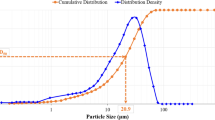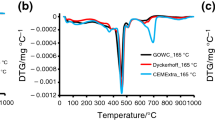Abstract
Cement is a poroelastic material rather than elastic material. Early researchers have measured the strengths and elastic properties of oil well cement, but Biot’s effective stress coefficient α remains an important unknown despite its significance to well integrity. Here, we present measurements of α for different types of oil well cement, which is calculated by the gradient of confining pressure to pore pressure under changing total stress conditions with bulk volumetric strain held constant. To ‘pause’ the hydration process at a specific number of days after mixing, the specimens were dried in a vacuum oven. This enabled nitrogen gas to be used for the Biot’s effective stress coefficient experiments, which accelerated the equilibration times from greater than 3 h to less than 10 min for each pressure step. Results show that for all cement systems except the Pozmix cement, the typical range of α is 0.38~0.80, compressibility is 1.0~5.7 \(\times {10}^{-10}\)/Pa, and permeability of 0.002~0.11 mD. We also measured the effect of effective stress, curing period, and curing condition on cement's poroelastic parameters of \(\alpha\), compressibility, permeability, and microstructures. Finally, we applied \(\alpha\) in a fully coupled thermoporoelastic model and found that Biot's effective stress coefficient plays a more important role in impermeable formations. This is caused by the induced/undrained pore pressure inside cement being significantly higher when the rock and cement permeability becomes lower. With a higher induced pore pressure, α will play a more significant role in maintaining well integrity. Under such circumstances, the flexible cement with lower elastic modulus and Poisson's ratio provides better performance in zonal isolation.
Highlights
-
We conducted comprehensive measurements of oil well cement's Biot's effective stress coefficient, compressibility, and permeability.
-
For most cement systems, Biot's effective stress coefficient is 0.38 ~ 0.80, and compressibility is 1.0 ~ 5.7 \(\times {10}^{-10}\)/Pa, and permeability of 0.002 ~ 0.11 mD.
-
Biot's effective stress coefficient is significant for the relatively impermeable wellbore systems with low permeability of cement and formation.














Similar content being viewed by others
References
API R (2013) 10B-2: recommended practice for testing well cements. API Recommended Practice B, 10
BiotWillis MADG (1957) The elastic coeffcients of the theory of consolidation. J Appl Mech 15:594–601
Carey JW, Wigand M, Chipera SJ et al (2007) Analysis and performance of oil well cement with 30 years of CO2 exposure from the SACROC Unit, West Texas, USA. Int J Greenh Gas Control 1(1):75–85
Civan F (2021a) Effective-stress coefficients of porous rocks involving shocks and loading/unloading hysteresis. SPE J 26(01):44–67
Civan F (2021b) Parameterization of biot-willis effective-stress coefficient for deformation and alteration of porous rocks. Transp Porous Media 138(2):337–368
Cosenza P, Ghoreychi M, De Marsily G, Vasseur G, Violette S (2002) Theoretical prediction of poroelastic properties of argillaceous rocks from in situ specific storage coefficient. Water Resour Res 38(10):25–31
Crow W, Carey JW, Gasda S, Williams DB, Celia M (2010) Wellbore integrity analysis of a natural CO2 producer. Int J Greenh Gas Control 4(2):186–197
Dassanayake ABN, Fujii Y, Fukuda F, Kodama JI (2015) A new approach to evaluate effective stress coefficient for strength in Kimachi sandstone. J Petrol Sci Eng 131:70–79
Franquet JA and Abass HH (1999) Experimental evaluation of Biot's poroelastic parameter three different methods. In: Paper presented at the 37th US Symposium on Rock Mechanics (USRMS). American Rock Mechanics Association. Vail Rocks
Ghabezloo S, Sulem J, Guédon S, Martineau F, Saint-Marc J (2008) Poromechanical behaviour of hardened cement paste under isotropic loading. Cement Concrete Res 38(12):1424–1437
Hasanov A, Batzle M, Prasad M (2015) The determination of reservoir poroelastic properties from oscillating pore pressure method. Paper Present SEG Tech Program Expand Abstracts 2015:3105–3110
He J, Rui Z, Ling K (2016) A new method to determine Biot’s coefficients of Bakken samples. J Nat Gas Sci Eng 35:259–264
Ingraham MD, Bauer SJ, Issen KA, Dewers TA (2017) Evolution of permeability and Biot coefficient at high mean stresses in high porosity sandstone. Int J Rock Mech Min Sci 96:1–10
Jennings HM (2000) A model for the microstructure of calcium silicate hydrate in cement paste. Cem Concr Res 30(1):101–116
Li W, An X, Li H (2018) Limestone mechanical deformation behavior and failure mechanisms: a review. Acta Geochimica 37(2):153–170
Ling K, He J, Pei P, Wang S and Ni X (2016) Comparisons of biot’s coefficients of bakken core samples measured by three methods. In: Paper presented at 50th US Rock Mechanics/Geomechanics Symposium. American Rock Mechanics Association. Houston, Texas, pp 26–29 June
Liu W, Yu B, Deng J (2017) Analytical method for evaluating stress field in casing-cement-formation system of oil/gas wells. Appl Math Mech 38(9):1273–1294
Liu K, Gao D, Taleghani AD (2018) Analysis on integrity of cement sheath in the vertical section of wells during hydraulic fracturing. J Petrol Sci Eng 168:370–379
Ma X, Zoback MD (2017) Laboratory experiments simulating poroelastic stress changes associated with depletion and injection in low-porosity sedimentary rocks. J Geophys Res Sol Ea 122(4):2478–2503
Meng M, Frash LP, Carey JW, Li W, Welch NJ, Zhang W (2021a) Cement stress and microstructure evolution during curing in semi-rigid high-pressure environments. Cem Concr Res 149:106555
Meng M, Frash L, Carey JW et al (2021b) Predicting cement-sheath integrity with consideration of initial state of stress and thermoporoelastic effects. SPE J 26(06):3505–3528
Meng M, Miska S, Yu M and Ozbayogu E (2019) Comparison and evaluation of failure criteria for cement sheath in the downhole situations. In: Paper presented at 53rd US Rock Mechanics/Geomechanics Symposium. American Rock Mechanics Association. New York City, New York. June 23–26
Meng M, Frash LP, Carey JW, Li W and Welch N (2020) Rapid measurement of Biot effective stress coefficient for Class-G Oil Well Cements. In: Paper presented at 54th US Rock Mechanics/Geomechanics Symposium. OnePetro
Meng M, Frash L, Carey JW, Li W, Welch N (2022) Measurement of cement in-situ mechanical properties with consideration of poroelasticity. SPE J 1–13
Niu Z, Shen J, Wang L, Yang R (2022) Thermo-poroelastic modelling of cement sheath: pore pressure response, thermal effect and thermo-osmotic effect. Eur J Environ Civ Eng 26(2):657–682
Pimienta L, Fortin J, Guéguen Y (2017) New method for measuring compressibility and poroelasticity coefficients in porous and permeable rocks. J Geophys Res Sol Ea 122(4):2670–2689
Saint-Marc J, Garnier A and Bois AP (2008) Initial state of stress: the key to achieving long-term cement-sheath integrity. In: Paper presented at SPE Annual Technical Conference and Exhibition, Denver, Colorado, USA, 21–24 September
Sheng G, Zhao H, Su Y, Javadpour F, Wang C, Zhou Y, Wang H (2020) An analytical model to couple gas storage and transport capacity in organic matter with noncircular pores. Fuel 268:117288
Thiercelin MJ, Dargaud B, Baret JF, Rodriquez WJ (1998) Cement design based on cement mechanical response. SPE Drill Compl 13(04):266–273
Ulm FJ, Constantinides G, Heukamp FH (2004) Is concrete a poromechanics materials?—A multiscale investigation of poroelastic properties. Mater Struct 37(1):43–58
Zhang Y, Hao S, Bai L, Yu Z, Zhang J, Fang J (2018) Thermomechanical behavior of late Indo-Chinese granodiorite under high temperature and pressure. J Eng 2018:1–15
Acknowledgements
Financial support for this work is gratefully acknowledged from the REX-CO2 project, which is funded through the ACT program (Accelerating CCS Technologies, Horizon2020 Project No. 299681). Financial contributions to REX-CO2 made from ADEME (FR); RVO (NL); Gassnova and RCN (NO); UEFISCDI (RO); BEIS, NERC, and EPSRC (UK); and US-DOE (USA) are gratefully acknowledged. We also gratefully acknowledge support from the U. S. Department of Energy (DOE) Office of Energy Efficiency & Renewable Energy’s Geothermal Technologies Office for “Advanced Downhole Acoustic Sensing for Wellbore Integrity” with award number of AC04-94AL85000.
Author information
Authors and Affiliations
Corresponding author
Additional information
Publisher's Note
Springer Nature remains neutral with regard to jurisdictional claims in published maps and institutional affiliations.
Rights and permissions
About this article
Cite this article
Meng, M., Frash, L.P., Carey, J.W. et al. Rapid Measurement of Biot’s Effective Stress Coefficient for Oil Well Cements with Application to Well Integrity. Rock Mech Rock Eng 56, 7115–7127 (2023). https://doi.org/10.1007/s00603-022-02972-y
Received:
Accepted:
Published:
Issue Date:
DOI: https://doi.org/10.1007/s00603-022-02972-y




